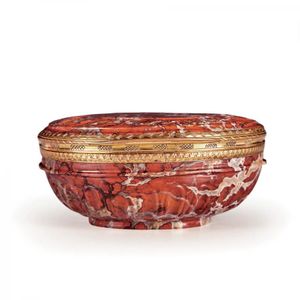Boxwood Rhinoceros Cup, Qing Dynasty
You must be a subscriber, and be logged in to view price and dealer details.
Subscribe Now to view actual auction price for this item
When you subscribe, you have the option of setting the currency in which to display prices to $Au, $US, $NZ or Stg.
- Boxwood - Boxwood is a hard, yellow coloured, close grained timber. In the 19th century it was often used for inlays, especially stringing, because of its contrasting colour to the darker timbers of the carcase. Stringing is the inlay of a narrow strip of veneer of a lighter colour, such as boxwood along or close to the edges of an object that has been veneered in a darker timber such as mahogany.
Because of its fine grain and resistnce to splitting or chipping it has also been used for treen, turnings, carvings and other small wooden items, such as chess pieces. - Qing Dynasty - The Qing Dynasty was the last imperial dynasty of China, ruling from 1644 to 1912. It was established by the Manchu people, who originated from the northeastern region of China. The Qing Dynasty was preceded by the Ming Dynasty and followed by the Republic of China.
- Ming Dynasty - The Ming Dynasty was a ruling dynasty of China from 1368 to 1644. It succeeded the Yuan Dynasty and preceded the Qing Dynasty. The Ming Dynasty was established by Zhu Yuanzhang, a former Buddhist monk who became a rebel leader and eventually overthrew the Mongol Yuan Dynasty. During the Ming Dynasty, China experienced a period of relative stability and prosperity. The government was centralized and bureaucratic, with the emperor at the top of the hierarchy. The Ming Dynasty is known for its cultural achievements, including the development of porcelain, the invention of movable type printing, and the construction of the Great Wall of China.
This item has been included into following indexes:
- Chinse sculpture - boxwood carvings and sculpture 109
- oriental carved ivory
Visually similar items

A Continental European cartouche-shaped gold-mounted box of carved translucent red Jasper c1,800, of beautiful quality, the cover fluted and the bowl fluted and banded, the mounts chased. Unmarked. Hairline crack to top, the fashion for small, highly worke

Two Ikebana vases, Japanese studio pottery school, Showa Period, stoneware, partly unglazed, one vase with artist's seal impressed to underside (2), height 21 cm, length 54 cm, height 13 cm, length 47.5 cm. Provenance: Collection of the Late Norman Sparnon

Loose opals two solid white opals, carved into a oval shape, 9.30ct and a flower, 4.20ct, white with green and red colour

Antique Japanese Imari bowl with later French mounts, 20 cm high, 23 cm diameter
